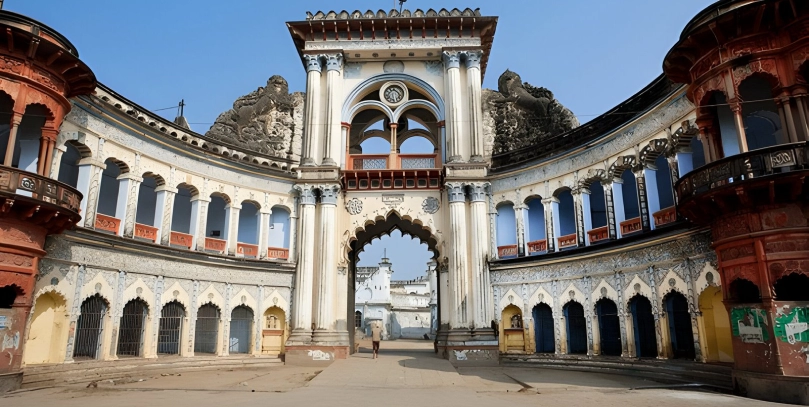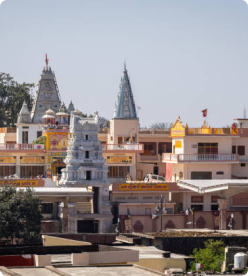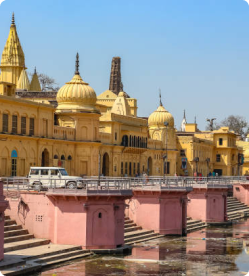Shri Ram Mandir Ayodhya: A Monument of Faith, History, and Cultural Reclamation
Kts Cabs
MRC20240900057
0+ Customer ContactedOur Fare Start from
Sedan - DZIRE, ETIOS OR SIMILAR
₹10.00 per km
250 km
SUV - ERTIGA OR SIMILAR
₹15.00 per km
250 km
Tempo Traveller - 15 Seater Tempo traveller
₹22.00 per km
300 km
Luxury Car - BMW
₹80.00 per km
300 km
Luxury Car - Mercedes-Benz
₹100.00 per km
300 km
-
₹300 per km
3000.00 km
Lucknow - Ayodhya
₹250 per km
3500.00 km
8/80 KM
₹80 per km
15.00 km
4/40km
₹40 per km
12.00 km
-
No Over Pricing
Cheapest Cost | Pay as you go
-
Get your first ride free up to ₹150*
-
No Return Fare
Oneway Cab Fare | No Hidden Charges
13 Taxi partners found in Ayodhya
Experience seamless rides with Ayodhya leading and verified taxi partners.
Select Type
To update price, included kms and extra fares
-
Tun Tun Cabs
MRC20241000111Location
AyodhyaExtra KM fare
₹ 10.00/km after 250 kmFuel Type
Petrol and CNG
-
Sri Swami Narayan Travels
MRC20241000120Location
AyodhyaExtra KM fare
₹ 10.00/km after 250 kmFuel Type
Petrol and CNG
-
Live Cabs
MRC20241000125Location
AyodhyaExtra KM fare
₹ 10.00/km after 250 kmFuel Type
Petrol and CNG
-
Mohit Tour And Travels
MRC20241000128Location
AyodhyaExtra KM fare
₹ 10.00/km after 250 kmFuel Type
Petrol and CNG
-
D. K. Tours And Travels
MRC20241000131Location
AyodhyaExtra KM fare
₹ 10.00/km after 250 kmFuel Type
Petrol and CNG
-
Urban Cab Service
MRC20241000134Location
AyodhyaExtra KM fare
₹ 10.00/km after 250 kmFuel Type
Petrol and CNG
-
Paawandham Darshan And Holidays
MRC20241000139Location
AyodhyaExtra KM fare
₹ 10.00/km after 250 kmFuel Type
Petrol and CNG
-
Sangam Tour And Travels
MRC20241000143Location
AyodhyaExtra KM fare
₹ 10.00/km after 250 kmFuel Type
Petrol and CNG
-
Abm Tour Travels
MRC20241000209Location
AyodhyaExtra KM fare
₹ 10.00/km after 250 kmFuel Type
Petrol and CNG
-
A Tour And Travels
MRC20241000210Location
AyodhyaExtra KM fare
₹ 10.00/km after 250 kmFuel Type
Petrol and CNG
-
A.k Tour Travels
MRC20241000212Location
AyodhyaExtra KM fare
₹ 10.00/km after 250 kmFuel Type
Petrol and CNG
-
Cabtrans Cab Services
MRC20241000344Location
AyodhyaExtra KM fare
₹ 10.00/km after 250 kmFuel Type
Petrol and CNG
-
Kts Cabs
MRC20240900057Location
AyodhyaExtra KM fare
₹ 10.00/km after 250 kmFuel Type
Petrol and CNG
-
Tun Tun Cabs
MRC20241000111Location
Ayodhya -Extra KM fare
₹ 10.00/km after 300 kmFuel Type
Petrol and CNG
-
Sri Swami Narayan Travels
MRC20241000120Location
Ayodhya -Extra KM fare
₹ 10.00/km after 300 kmFuel Type
Petrol and CNG
-
Live Cabs
MRC20241000125Location
Ayodhya -Extra KM fare
₹ 10.00/km after 300 kmFuel Type
Petrol and CNG
-
Mohit Tour And Travels
MRC20241000128Location
Ayodhya -Extra KM fare
₹ 10.00/km after 300 kmFuel Type
Petrol and CNG
-
D. K. Tours And Travels
MRC20241000131Location
Ayodhya -Extra KM fare
₹ /km after kmFuel Type
Petrol and CNG
-
Urban Cab Service
MRC20241000134Location
Ayodhya -Extra KM fare
₹ 10.00/km after 300 kmFuel Type
Petrol and CNG
-
Paawandham Darshan And Holidays
MRC20241000139Location
Ayodhya -Extra KM fare
₹ 10.00/km after 300 kmFuel Type
Petrol and CNG
-
Sangam Tour And Travels
MRC20241000143Location
Ayodhya -Extra KM fare
₹ 10.00/km after 300 kmFuel Type
Petrol and CNG
-
Abm Tour Travels
MRC20241000209Location
Ayodhya -Extra KM fare
₹ 10.00/km after 300 kmFuel Type
Petrol and CNG
-
A Tour And Travels
MRC20241000210Location
Ayodhya -Extra KM fare
₹ 10.00/km after 300 kmFuel Type
Petrol and CNG
-
A.k Tour Travels
MRC20241000212Location
Ayodhya -Extra KM fare
₹ 10.00/km after 300 kmFuel Type
Petrol and CNG
-
Cabtrans Cab Services
MRC20241000344Location
Ayodhya -Extra KM fare
₹ 10.00/km after 300 kmFuel Type
Petrol and CNG
-
Kts Cabs
MRC20240900057Location
Ayodhya -Extra KM fare
₹ 15.00/km after 250 kmFuel Type
Petrol and CNG
-
Tun Tun Cabs
MRC20241000111Package Name
8/80 KMExtra KM fare
₹ 12.00/km after 80 kmFuel Type
Petrol and CNG
-
Sri Swami Narayan Travels
MRC20241000120Package Name
8/80 KMExtra KM fare
₹ 12.00/km after 80 kmFuel Type
Petrol and CNG
-
Live Cabs
MRC20241000125Package Name
8/80 KMExtra KM fare
₹ 12.00/km after 80 kmFuel Type
Petrol and CNG
-
Mohit Tour And Travels
MRC20241000128Package Name
8/80 KMExtra KM fare
₹ 12.00/km after 80 kmFuel Type
Petrol and CNG
-
D. K. Tours And Travels
MRC20241000131Package Name
Extra KM fare
₹ /km after kmFuel Type
Petrol and CNG
-
Urban Cab Service
MRC20241000134Package Name
8/80 KMExtra KM fare
₹ 12.00/km after 80 kmFuel Type
Petrol and CNG
-
Paawandham Darshan And Holidays
MRC20241000139Package Name
8/80 KMExtra KM fare
₹ 12.00/km after 80 kmFuel Type
Petrol and CNG
-
Sangam Tour And Travels
MRC20241000143Package Name
8/80 KMExtra KM fare
₹ 12.00/km after 80 kmFuel Type
Petrol and CNG
-
Abm Tour Travels
MRC20241000209Package Name
8/80 KMExtra KM fare
₹ 12.00/km after 80 kmFuel Type
Petrol and CNG
-
A Tour And Travels
MRC20241000210Package Name
8/80 KMExtra KM fare
₹ 12.00/km after 80 kmFuel Type
Petrol and CNG
-
A.k Tour Travels
MRC20241000212Package Name
8/80 KMExtra KM fare
₹ 12.00/km after 80 kmFuel Type
Petrol and CNG
-
Cabtrans Cab Services
MRC20241000344Package Name
8/80 KMExtra KM fare
₹ 12.00/km after 80 kmFuel Type
Petrol and CNG
-
Kts Cabs
MRC20240900057Package Name
8/80 KMExtra KM fare
₹ 15.00/km after 80 kmFuel Type
Petrol and CNG
-
Tun Tun Cabs
MRC20241000111Location
AyodhyaExtra KM fare
₹ /km after kmFuel Type
Petrol and CNG
-
Sri Swami Narayan Travels
MRC20241000120Location
AyodhyaExtra KM fare
₹ /km after kmFuel Type
Petrol and CNG
-
Live Cabs
MRC20241000125Location
AyodhyaExtra KM fare
₹ /km after kmFuel Type
Petrol and CNG
-
Mohit Tour And Travels
MRC20241000128Location
AyodhyaExtra KM fare
₹ /km after kmFuel Type
Petrol and CNG
-
D. K. Tours And Travels
MRC20241000131Location
AyodhyaExtra KM fare
₹ /km after kmFuel Type
Petrol and CNG
-
Urban Cab Service
MRC20241000134Location
AyodhyaExtra KM fare
₹ /km after kmFuel Type
Petrol and CNG
-
Paawandham Darshan And Holidays
MRC20241000139Location
AyodhyaExtra KM fare
₹ /km after kmFuel Type
Petrol and CNG
-
Sangam Tour And Travels
MRC20241000143Location
AyodhyaExtra KM fare
₹ /km after kmFuel Type
Petrol and CNG
-
Abm Tour Travels
MRC20241000209Location
AyodhyaExtra KM fare
₹ /km after kmFuel Type
Petrol and CNG
-
A Tour And Travels
MRC20241000210Location
AyodhyaExtra KM fare
₹ /km after kmFuel Type
Petrol and CNG
-
A.k Tour Travels
MRC20241000212Location
AyodhyaExtra KM fare
₹ /km after kmFuel Type
Petrol and CNG
-
Cabtrans Cab Services
MRC20241000344Location
AyodhyaExtra KM fare
₹ /km after kmFuel Type
Petrol and CNG
-
Kts Cabs
MRC20240900057Location
AyodhyaExtra KM fare
₹ /km after kmFuel Type
Petrol and CNG
Shri Ram Mandir Ayodhya: Monument of Faith, History and Cultural Reclamation
At the heart of Ayodhya, the city woven with mythology, history, and spirituality, stands the grand Shri Ram Mandir. Since times immemorial, this land has been a sacred Hindu pilgrimage center because it is said to be the birthplace of Lord Ram. The Shri Ram Mandir is an architectural wonder but also stands out as a testament of unbreakable faith and India's rich cultural heritage.
Shri Ram Mandir Ayodhya : Tracing the Historical Journey of Lord Ram
The Shri Ram Mandir in Ayodhya is far more than a place of worship: it is directly connected in an intimate way with the historical and mythological heritage of Lord Ram..
According to ancient texts, it is the birthplace of Lord Ram-one of India's holiest cities. For centuries, pilgrims have considered it a long-standing tradition to strive towards this sacred city in pursuit of being blessed by Lord Ram and praying for peace and prosperity.
The Ramayana is an ancient epic in which the story of Lord Ram occurs while proceeding in and out of exile to regaining his kingdom status. Shri Ram Mandir Ayodhya takes place annually on the day of Diwali, which marks the victory of good over evil and light over darkness.
The Historical Background of Shri Ram Mandir Ayodhya
Ayodhya's past, especially regarding the Ram Janmabhoomi site, has been mired in religious and political animosity for centuries. The Babri Masjid was built upon this sacred place in the 16th century, as it was believed to be the birthplace of Lord Ram. The disputed mosque was destroyed on December 6, 1992, and over the mosque's site led to rioting and communal disturbance across the nation. For decades, finally, the legal battle seems to have come to an end with the Supreme Court of India's judgment delivered in 2019 that the construction of the Ram Mandir at the site in dispute is acceptable and there can be a separate land to be used in building the mosque. This great end comes to this struggle that haunted for so long.
A symbol of cultural reclamation Shri Ram Mandir Ayodhya
It is more than the religious construction of Shri Ram Mandir-by one, a moment of cultural revival as well as national unity. The temple marks the retrieval of Lord Ram's birthplace and puts into the fore 'conserving India's richly diversiform cultural and spiritual heritage'.
Shri Ram Mandir is that light of India with its valuable traditions, spiritual devotion, and the power of faith. It stands as a collective aspiration of millions of devotees who have revered Lord Ram through the ages.
Architectural Splendour of Shri Ram Mandir Ayodhya
The Shri Ram Mandir is the epitome of architecture as it speaks divinity with grandeur combined with minute craftsmanship.. Breathtaking monuments are crowned with majestic spires, carvings, and sculptures of scenes from the Ramayana, held in time, both the work of an artist and a devotee. From craftsmen all over India comes the expertise, using native means and materials to create this gem.
Similarly, the architecture of the temple depicts the restoration of ancient architectural methodology, symbolizing the beauty of Indian craftsmanship along with the cultural heritage of Ayodhya.
Ayodhya and Shri Ram Mandir: A Symbol of National Unity
On the other hand, the construction of the Shri Ram Mandir brought people across different walks of life into a cohesive unit. Above the religious and political differences which segregate this multifaceted Indian society, it serves as a uniting force. It is the symbol of national pride which means spiritual regeneration for millions of followers.They have also generated some income for the local Ayodhya economy by providing jobs and tourism. It has made people proud of their lineage.
Conclusion:
Shri Ram Mandir Ayodhya stands as a monumental testimony to the legacy of Lord Ram, reflecting faith, unity, and culture. This is a temple built after decades of struggle and perseverance symbolizing hope, inspiration, and a cherished dream come true for millions of devotees and pilgrims.

Top cabs from Ayodhya
| Cabs from Ayodhya | Included kms & fare | Cab Price |
|---|
FAQs
Ayodhya Ram temple's 1st, 2nd floors will be ready by December 2024. The construction of Ram temple in Ayodhya is expected to be completed by December 2021. The temple complex will include other structures as well. The consecration ceremony is scheduled for January 22, and Prime Minister Narendra Modi will attend.
The completion of the temple is expected to have a significant socio-economic impact on the local community in Ayodhya. It will boost tourism, create employment opportunities, and stimulate economic growth in the region. Additionally, it will enhance the cultural and religious significance of Ayodhya as a pilgrimage destination.
The construction of the temple is funded through voluntary donations from devotees, organizations, and philanthropists. The Shri Ram Janmabhoomi Teerth Kshetra Trust is responsible for managing the funds and ensuring transparency in the construction process.
The temple complex will include the main sanctum sanctorum housing the idol of Lord Ram, along with other shrines dedicated to other deities associated with the Ramayana. Additionally, there will be facilities for devotees such as meditation halls, accommodation, and dining facilities.
Currently, the temple is not open to visitors as construction work is still underway. However, once completed, it is expected to become a major pilgrimage site and tourist attraction, welcoming devotees and visitors from around the world.
The temple is being built in the Nagara style of temple architecture, which is typical of North Indian temples. It features intricate carvings, majestic spires (shikharas), and ornate sculptures depicting scenes from the Ramayana. Skilled artisans and craftsmen from across India are involved in the construction, employing traditional techniques and materials.
The foundation stone for the construction of the temple was laid on August 5, 2020, during a historic ceremony attended by Prime Minister Narendra Modi and other dignitaries. Since then, the construction work has been underway, with the goal of completing the temple within a specified timeline.
The construction of the temple is being overseen by the Shri Ram Janmabhoomi Teerth Kshetra Trust, established by the Government of India. The trust is responsible for the planning, funding, and execution of the temple project.
The temple holds immense cultural, religious, and historical significance for Hindus. It symbolizes the birthplace of Lord Ram, a central figure in Hinduism and the protagonist of the epic Ramayana. The construction of the temple marks the culmination of a decades-long struggle and legal battle over the disputed site.
The Shri Ram Mandir Ayodhya is a temple dedicated to Lord Ram, believed to be the birthplace of the revered deity according to Hindu mythology. It is being constructed at the Ram Janmabhoomi site in Ayodhya, Uttar Pradesh, India.
Explore Our Traveller Tales
View MoreShri Ram Mandir Ayodhya
Outstation Taxi Services
- Outstation Taxi Services in Agra
- Outstation Taxi Services in Aligarh
- Outstation Taxi Services in Ambedkar Nagar
- Outstation Taxi Services in Amethi
- Outstation Taxi Services in Amroha
- Outstation Taxi Services in Auraiya
- Outstation Taxi Services in Ayodhya
- Outstation Taxi Services in Azamgarh
- Outstation Taxi Services in Badaun
- Outstation Taxi Services in Baghpat
- Outstation Taxi Services in Bahraich
- Outstation Taxi Services in Ballia
- Outstation Taxi Services in Balrampur
- Outstation Taxi Services in Banda
- Outstation Taxi Services in Barabanki
- Outstation Taxi Services in Bareilly
- Outstation Taxi Services in Basti
- Outstation Taxi Services in Bijnor
- Outstation Taxi Services in Bulandshahr
- Outstation Taxi Services in Chandauli
- Outstation Taxi Services in Chitrakoot
- Outstation Taxi Services in Etah
- Outstation Taxi Services in Etawah
- Outstation Taxi Services in Farrukhabad
- Outstation Taxi Services in Fatehpur
- Outstation Taxi Services in Firozabad
- Outstation Taxi Services in Gautam Buddha Nagar
- Outstation Taxi Services in Ghaziabad
- Outstation Taxi Services in Ghazipur
- Outstation Taxi Services in Gonda
- Outstation Taxi Services in Gorakhpur
- Outstation Taxi Services in Hamirpur
- Outstation Taxi Services in Hapur
- Outstation Taxi Services in Hardoi
- Outstation Taxi Services in Hathras
- Outstation Taxi Services in Jalaun
- Outstation Taxi Services in Jaunpur
- Outstation Taxi Services in Jhansi
- Outstation Taxi Services in Kannauj
- Outstation Taxi Services in Kanpur
- Outstation Taxi Services in Kasganj
- Outstation Taxi Services in Kaushambi
- Outstation Taxi Services in Kushinagar
- Outstation Taxi Services in Lakhimpur Kheri
- Outstation Taxi Services in Lalitpur
- Outstation Taxi Services in Lucknow
- Outstation Taxi Services in Mahoba
- Outstation Taxi Services in Mainpuri
- Outstation Taxi Services in Mathura
- Outstation Taxi Services in Mau
- Outstation Taxi Services in Meerut
- Outstation Taxi Services in Mirzapur
- Outstation Taxi Services in Moradabad
- Outstation Taxi Services in Mughalsarai
- Outstation Taxi Services in Muirpur
- Outstation Taxi Services in Muzaffarnagar
- Outstation Taxi Services in Noida
- Outstation Taxi Services in Pilibhit
- Outstation Taxi Services in Pratapgarh
- Outstation Taxi Services in Prayagraj
- Outstation Taxi Services in Raebareli
- Outstation Taxi Services in Rampur
- Outstation Taxi Services in Saharanpur
- Outstation Taxi Services in Sambhal
- Outstation Taxi Services in Sant Kabir Nagar
- Outstation Taxi Services in Shahjahanpur
- Outstation Taxi Services in Shamli
- Outstation Taxi Services in Shravasti
- Outstation Taxi Services in Siddharthnagar
- Outstation Taxi Services in Sitapur
- Outstation Taxi Services in Sonbhadra
- Outstation Taxi Services in Sultanpur
- Outstation Taxi Services in Unnao
- Outstation Taxi Services in Varanasi
- Outstation Taxi Services in Vrindavan
Oneway Cabs
- One Way cab hire in Ambedkar Nagar
- One Way cab hire in Amethi
- One Way cab hire in Amroha
- One Way cab hire in Auraiya
- One Way cab hire in Badaun
- One Way cab hire in Baghpat
- One Way cab hire in Bahraich
- One Way cab hire in Ballia
- One Way cab hire in Balrampur
- One Way cab hire in Banda
- One Way cab hire in Barabanki
- One Way cab hire in Basti
- One Way cab hire in Bijnor
- One Way cab hire in Bulandshahr
- One Way cab hire in Chandauli
- One Way cab hire in Etah
- One Way cab hire in Etawah
- One Way cab hire in Farrukhabad
- One Way cab hire in Fatehpur
- One Way cab hire in Firozabad
- One Way cab hire in Gautam Buddha Nagar
- One Way cab hire in Ghazipur
- One Way cab hire in Gonda
- One Way cab hire in Hamirpur
- One Way cab hire in Hapur
- One Way cab hire in Hardoi
- One Way cab hire in Hathras
- One Way cab hire in Jalaun
- One Way cab hire in Jaunpur
- One Way cab hire in Kannauj
- One Way cab hire in Kasganj
- One Way cab hire in Kaushambi
- One Way cab hire in Lakhimpur Kheri
- One Way cab hire in Lalitpur
- One Way cab hire in Mahoba
- One Way cab hire in Mainpuri
- One Way cab hire in Mau
- One Way cab hire in Mirzapur
- One Way cab hire in Mughalsarai
- One Way cab hire in Muzaffarnagar
- One Way cab hire in Pilibhit
- One Way cab hire in Pratapgarh
- One Way cab hire in Raebareli
- One Way cab hire in Rampur
- One Way cab hire in Saharanpur
- One Way cab hire in Sambhal
- One Way cab hire in Sant Kabir Nagar
- One Way cab hire in Shahjahanpur
- One Way cab hire in Shamli
- One Way cab hire in Siddharthnagar
- One Way cab hire in Sitapur
- One Way cab hire in Sonbhadra
- One Way cab hire in Sultanpur
- One Way cab hire in Unnao
- One Way cab hire in Vrindavan
- One Way Car Rental Services in Agra
- One Way Car Rental Services in Aligarh
- One Way Car Rental Services in Ayodhya
- One Way Car Rental Services in Azamgarh
- One Way Car Rental Services in Bareilly
- One Way Car Rental Services in Chitrakoot
- One Way Car Rental Services in Ghaziabad
- One Way Car Rental Services in Gorakhpur
- One Way Car Rental Services in Jhansi
- One Way Car Rental Services in Kanpur
- One Way Car Rental Services in Mathura
- One Way Car Rental Services in Meerut
- One Way Car Rental Services in Moradabad
- One Way Car Rental Services in Muirpur
- One Way Car Rental Services in Noida
- One Way Car Rental Services in Prayagraj
- One Way Car Rental Services in Shravasti
- One Way Car Rental Services in Varanasi
- One Way Car Taxi Services in Kushinagar
- One Way Taxi Services in Lucknow
Airport Taxi Booking
- Mirzapur to Varanasi (VNS) Airport Taxi
- Airport Transfer Taxi Services in Agra
- Airport Transfer Taxi Services in Aligarh
- Airport Transfer Taxi Services in Azamgarh
- Airport Transfer Taxi Services in Bareilly
- Airport Transfer Taxi Services in Chitrakoot
- Airport Transfer Taxi Services in Ghaziabad
- Airport Transfer Taxi Services in Gorakhpur
- Airport Transfer Taxi Services in Jhansi
- Airport Transfer Taxi Services in Kanpur
- Airport Transfer Taxi Services in Kushinagar
- Airport Transfer Taxi Services in Mathura
- Airport Transfer Taxi Services in Meerut
- Airport Transfer Taxi Services in Moradabad
- Airport Transfer Taxi Services in Muirpur
- Airport Transfer Taxi Services in Noida
- Airport Transfer Taxi Services in Prayagraj
- Airport Transfer Taxi Services in Shravasti
- Airport Transfer Taxi Services in Varanasi
- Ambedkar Nagar to Varanasi Airport Taxi
- Amethi to Lucknow Airport Taxi
- Amroha to New Delhi Airport Taxi
- Auraiya to Kanpur Airport Taxi
- Ayodhya Airport Taxi Service
- Badaun to Agra Airport (AGR) Taxi
- Baghpat to New Delhi Airport Taxi
- Bahraich to Lucknow Airport Taxi
- Ballia to Lucknow Airport Taxi
- Balrampur to Lucknow Airport Taxi
- Banda to Lucknow Airport Taxi
- Barabanki to Lucknow Airport Taxi
- Basti to Gorakhpur Airport Taxi
- Bijnor to Lucknow Airport Taxi
- Bulandshahr to New Delhi Airport Taxi
- Chandauli to Varanasi Airport Taxi
- Etah to Agra Airport Taxi
- Etawah to Lucknow Airport Taxi
- Farrukhabad to Lucknow Airport Taxi
- Fatehpur to Lucknow Airport Taxi
- Firozabad to Agra Airport Taxi
- Gautam Buddha Nagar to New Delhi Airport Taxi
- Ghazipur to Varanasi Airport Taxi
- Gonda to Lucknow Airport Taxi
- Hamirpur to Lucknow Airport Taxi
- Hapur to Lucknow Airport Taxi
- Hardoi to Lucknow Airport Taxi
- Hathras to Agra Airport Taxi
- Jalaun to Kanpur Airport Taxi
- Jaunpur to Varanasi Airport Taxi Service
- Kannauj to Lucknow Airport Taxi
- Kasganj to Agra Airport Taxi
- Kaushambi to Prayagraj Airport Taxi
- Lakhimpur Kheri to Lucknow Airport Taxi
- Lalitpur to Kanpur Airport Taxi
- Lucknow Airport Taxi Service
- Mahoba to Kanpur Airport Taxi
- Mainpuri to Agra Airport Taxi
- Mau to Gorakhpur Airport Taxi
- Mugal Sarai to Varanasi Airport Taxi
- Muzaffarnagar to New Delhi Airport Taxi
- Pilibhit to Bareilly Airport Taxi Service
- Pratapgarh to Varanasi Airport Taxi
- Raebareli to Lucknow Airport Taxi
- Rampur to Lucknow Airport Taxi
- Saharanpur to New Delhi Airport Taxi
- Sambhal to Bareilly Airport Taxi
- Sant Kabir Nagar to Gorakhpur Airport Taxi
- Shahjahanpur to Lucknow Airport Taxi
- Shamli to Lucknow Airport Taxi
- Siddharthnagar to Gorakhpur Airport Taxi
- Sitapur to Lucknow Airport Taxi
- Sonbhadra to Varanasi Airport Taxi
- Sultanpur to Ayodhya Airport (AYJ) taxi
- Unnao to Lucknow Airport Taxi
- Vrindavan to Agra Airport Taxi
Corporate Car Rentals
- Corporate Car Rental Services in Agra
- Corporate Car Rental Services in Aligarh
- Corporate Car Rental Services in Ayodhya
- Corporate Car Rental Services in Azamgarh
- Corporate Car Rental Services in Bareilly
- Corporate Car Rental Services in Chitrakoot
- Corporate Car Rental Services in Ghaziabad
- Corporate Car Rental Services in Gorakhpur
- Corporate Car Rental Services in Jhansi
- Corporate Car Rental Services in Kanpur
- Corporate Car Rental Services in Kushinagar
- Corporate Car Rental Services in Lucknow
- Corporate Car Rental Services in Mathura
- Corporate Car Rental Services in Meerut
- Corporate Car Rental Services in Moradabad
- Corporate Car Rental Services in Muirpur
- Corporate Car Rental Services in Noida
- Corporate Car Rental Services in Prayagraj
- Corporate Car Rental Services in Shravasti
- Corporate Car Rental Services in Varanasi
Luxury Car Rental Services
- Luxury Car Hire services in Agra
- Luxury Car Hire services in Aligarh
- Luxury Car Hire services in Ayodhya
- Luxury Car Hire services in Azamgarh
- Luxury Car Hire services in Bareilly
- Luxury Car Hire services in Chitrakoot
- Luxury Car Hire services in Ghaziabad
- Luxury Car Hire services in Gorakhpur
- Luxury Car Hire services in Jhansi
- Luxury Car Hire services in Kanpur
- Luxury Car Hire services in Kushinagar
- Luxury Car Hire Services in Lucknow
- Luxury Car Hire services in Mathura
- Luxury Car Hire services in Meerut
- Luxury Car Hire services in Moradabad
- Luxury Car Hire services in Muirpur
- Luxury Car Hire services in Noida
- Luxury Car Hire services in Prayagraj
- Luxury Car Hire services in Shravasti
- Luxury Car Hire services in Varanasi
Tempo Tarveller on Rent
- Tempo Traveller Rental Service in Bareilly
- Tempo Traveller Rental Services in Aligarh
- Tempo Traveller Rental Services in Ambedkar Nagar
- Tempo Traveller Rental Services in Amethi
- Tempo Traveller Rental Services in Amroha
- Tempo Traveller Rental Services in Auraiya
- Tempo Traveller Rental Services in Ayodhya
- Tempo Traveller Rental Services in Azamgarh
- Tempo Traveller Rental Services in Badaun
- Tempo Traveller Rental Services in Baghpat
- Tempo Traveller Rental Services in Bahraich
- Tempo Traveller Rental Services in Ballia
- Tempo Traveller Rental Services in Balrampur
- Tempo Traveller Rental Services in Banda
- Tempo Traveller Rental Services in Barabanki
- Tempo Traveller Rental Services in Basti
- Tempo Traveller Rental Services in Bijnor
- Tempo Traveller Rental Services in Bulandshahr
- Tempo Traveller Rental Services in Chandauli
- Tempo Traveller Rental Services in Chitrakoot
- Tempo Traveller Rental Services in Etah
- Tempo Traveller Rental Services in Etawah
- Tempo Traveller Rental Services in Farrukhabad
- Tempo Traveller Rental Services in Fatehpur
- Tempo Traveller Rental Services in Firozabad
- Tempo Traveller Rental Services in Gautam Buddha Nagar
- Tempo Traveller Rental Services in Ghaziabad
- Tempo Traveller Rental Services in Ghazipur
- Tempo Traveller Rental Services in Gonda
- Tempo Traveller Rental Services in Gorakhpur
- Tempo Traveller Rental Services in Hamirpur
- Tempo Traveller Rental Services in Hapur
- Tempo Traveller Rental Services in Hardoi
- Tempo Traveller Rental Services in Hathras
- Tempo Traveller Rental Services in Jalaun
- Tempo Traveller Rental Services in Jaunpur
- Tempo Traveller Rental Services in Jhansi
- Tempo Traveller Rental Services in Kannauj
- Tempo Traveller Rental Services in Kanpur
- Tempo Traveller Rental Services in Kasganj
- Tempo Traveller Rental Services in Kaushambi
- Tempo Traveller Rental Services in Kushinagar
- Tempo Traveller Rental Services in Lakhimpur Kheri
- Tempo Traveller Rental Services in Lalitpur
- Tempo Traveller Rental Services in Mahoba
- Tempo Traveller Rental Services in Mainpuri
- Tempo Traveller Rental Services in Mathura
- Tempo Traveller Rental Services in Mau
- Tempo Traveller Rental Services in Meerut
- Tempo Traveller Rental Services in Mirzapur
- Tempo Traveller Rental Services in Mugal Sarai
- Tempo Traveller Rental Services in Muirpur
- Tempo Traveller Rental Services in Muzaffarnagar
- Tempo Traveller Rental Services in Noida
- Tempo Traveller Rental Services in Pilibhit
- Tempo Traveller Rental Services in Pratapgarh
- Tempo Traveller Rental Services in Prayagraj
- Tempo Traveller Rental Services in Raebareli
- Tempo Traveller Rental Services in Rampur
- Tempo Traveller Rental Services in Saharanpur
- Tempo Traveller Rental Services in Sambhal
- Tempo Traveller Rental Services in Sant Kabir Nagar
- Tempo Traveller Rental Services in Shahjahanpur
- Tempo Traveller Rental Services in Shamli
- Tempo Traveller Rental Services in Shravasti
- Tempo Traveller Rental Services in Siddharthnagar
- Tempo Traveller Rental Services in Sitapur
- Tempo Traveller Rental Services in Sonbhadra
- Tempo Traveller Rental Services in Sultanpur
- Tempo Traveller Rental Services in Unnao
- Tempo Traveller Rental Services in Varanasi
- Tempo Traveller Rental Services in Vrindavan
- Tempo Traveller On Rent In Agra
- Tempo Traveller on Rent in Lucknow
- Tempo Traveller On Rent In Moradabad
Taxi fare in Ayodhya
Fleet For Ayodhya
-

- Toyota Etios Liva
₹ 16.0080₹ 1280.00 -

Sedan - DZIRE, ETIOS OR SIMILAR
₹ 11.00250₹ 2750.00 -

SUV - ERTIGA OR SIMILAR
₹ 17.00250₹ 4250.00 -

Tempo Traveller - 15 Seater Tempo traveller
₹ 25.00350₹ 8750.00 -

Luxury Car - BMW
₹ 90.00300₹ 27000.00 -

Luxury Car - Audi
₹ 90.00300₹ 27000.00 -

Luxury Car - Mercedes-Benz
₹ 100.00300₹ 30000.00
















